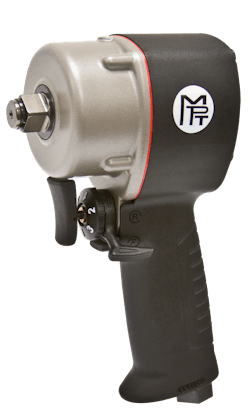Tool Review: Michigan Pneumatic 1/2" Stubby Impact Wrench
The 1/2" Stubby Impact Wrench, No. MP-7775, from Michigan Pneumatic Tool features a lightweight composite motor housing. The compact wrench allows for one-handed operation, has three speed settings and left-handed or right-handed reverse options. This tool is ideal for tight applications. The tool runs at 9,000 rpm and delivers 500 ft-lbs of torque in forward and 900 ft-lbs in reverse. The MP-7775 is a durable tool with a jumbo clutch.
The review
When working in the shop, an impact is a must-have tool. But, there is often a trade-off between size and power. Matt Fanslow of Riverside Automotive in Red Wing, Minnesota, appreciated that this stubby impact was small enough to fit into tight spaces without compromising power.
“This tool allows you to fit a surprisingly powerful pistol-style impact in areas you never would have been able to before,” Fanslow says. “Prior to using a tool like this, you would need a pry bar to hold a component and a breaker-bar to loosen a fastener. With this, there is no need. This thing hits hard.”
Fanslow used this stubby impact for engine work, chassis work and suspension work.
“It really shines with engine work in the engine compartment,” Fanslow notes. “It is small enough to get into tight spaces and [offers] excellent power compared to our other well-known impact manufacturers.”
Setup for this tool was simple, Fanslow says: simply connect the appropriate fitting for the air hose, drip in a small dose of air tool lubricant and the tool is ready to go. The impact did include a manual, but Fanslow didn’t use it, because he found the tool to be very intuitive.
Fanslow’s favorite feature was the small size.
“It is very intuitive to use and literally fits into the palm of your hand,” he says. “The size allows you to palm the impact while actuating the trigger with your middle finger. In cramped quarters, this was [our] preferred method of using the tool.”
As a suggestion for improvement, Fanslow notes that he found the anvil didn’t hold sockets as well as he would like.
“If allowed to free run, the socket would wobble and fly off,” he says. “I would not qualify it as a big issue, because it was a rare occurrence. My fear would be that over time, sockets would not stay on while finessing the tool into position.”
To remedy this issue, he would like to see the anvil redesigned for a more positive lock with sockets.
Overall, Fanslow found this tool easy to use and powerful enough to get the job done.
“It has great power, balance and size,” he concludes. “It’s great for working in cramped quarters.”
About the Author
Stefanie Von Rueden
Assistant Editor - Vehicle Repair Group
Stefanie Von Rueden is assistant editor for the Vehicle Repair Group.
Von Rueden’s background includes professional writing and publishing. Previously, she worked in the Continuing Education department at UW-Whitewater. She has covered the vehicle maintenance and automotive aftermarket since 2016.

